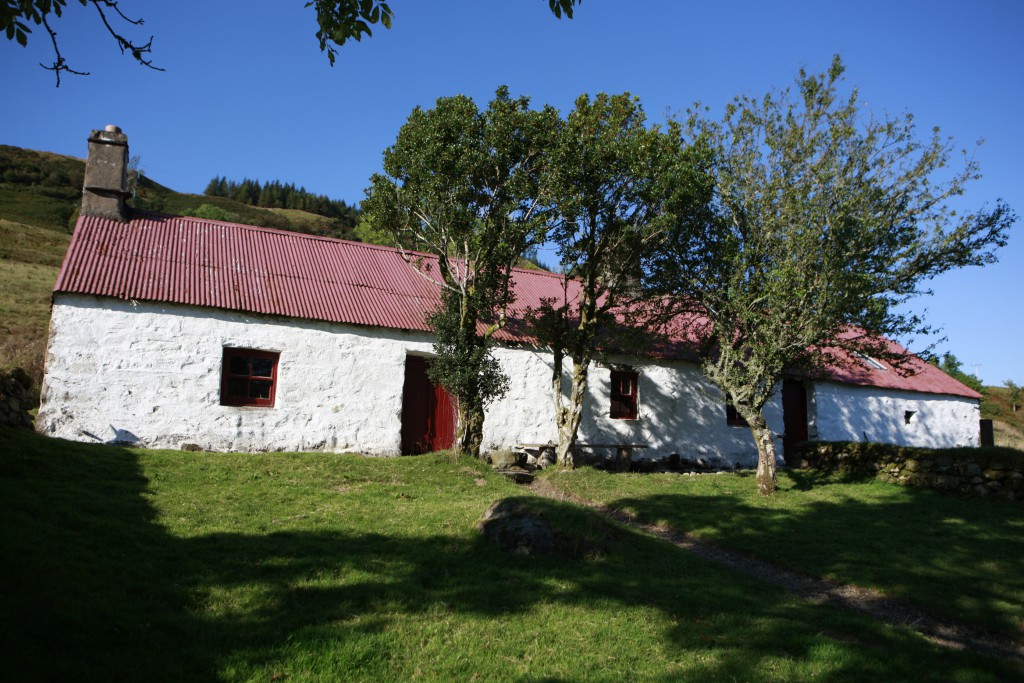About Auchindrain
Auchindrain is a museum representing an important part of Scotland’s past. The 22-acre site, deep in the stunning Argyll countryside, contains the houses and other buildings of a small farming community known as a township. Back in history Scotland had relatively few cities and towns. Most people lived in the country, worked as farmers and lived in a township – there were once thousands of places like this.
In a township, a group of families lived alongside each other, sharing the land and the work, growing their own food, and breeding cattle (from around 1850, sheep) to sell. They were most common in the north and west of Scotland, and evolved so that people could survive in a mountainous and unforgiving landscape with poor soil and a cold, wet climate. Life in a township was extremely harsh: people had few possessions, very little money, and starvation was always just around the corner.
In the 1700s, new ways of farming started to develop, based on better and more scientific understanding of things like land drainage, animal breeding and crops such as potatoes and turnips. Landowners, supported by the new knowledge and encouraged by increasing demand for everything that the land could produce, began a process known as agricultural improvement – the farming equivalent of the industrial revolution that was transforming cities like Glasgow. The townships with their communal way of life were seen as an obstacle to change. More could be produced from the land and there was more money to be made, but the townships and their people were in the way.
Over about a hundred years from around 1750 almost all of Scotland’s townships were improved out of existence. In some places they were replaced by modern-style farms run by tenants who could apply the new ways and which employed people as agricultural labourers. In others they were divided up into crofts, Small individual tenancies that deliberately did not provide a family with enough land to earn a living – the system was partly intended to provide a captive workforce for new industrial enterprises. Some landowners had the townships demolished and sent the people away so that the land could be used to graze large flocks of sheep managed by a few shepherds, or sometimes as private sporting estates. The process, known as the Highland Clearances (although not all landowners actually evicted the people who had been their tenants in the old townships) was brutal, often traumatic, and changed the face of rural Scotland for ever. By around 1850 most townships had gone. A few seem to have survived into the late 1800s and early 1900s, by moving with the times and changing their approach to farming and the construction of buildings. Auchindrain was the last, remaining a genuine community into the 1930s before the number of tenants dropped to just one. Farming ended here in 1963, the last people moved away in 1967, and the township has been open to visitors as a museum since 1968.
Today, Auchindrain is a very special place indeed: there is nowhere else like it, in Scotland or elsewhere. During the main period of agricultural improvement, between about 1780 and 1860, it kept its traditional communal structure and was not divided up into crofts or rebuilt as a modern-style farm. As a consequence it retains much of the character and layout of a traditional township – a random scatter of simple buildings set in a landscape that has changed relatively little in centuries. The preserved buildings give an authentic insight into how people lived and worked. There’s nothing staged or glossy, and what you see creates a powerful picture of the lives of ordinary people. You can wander freely around the houses and farm buildings, see where the animals grazed and where crops were grown. The houses are furnished with everyday objects and you’ll find old farming tools and implements in the barns. It feels as if the people have just gone out for the day.

Auchindrain is truly a place in Scotland’s history: a reminder of how we once were. It has particular significance for people around the world of Scottish descent in countries like the USA, Canada, Australia and New Zealand. If this is you, the reality is that your ancestors almost certainly came from a township, and either chose to emigrate to seek a life that was not so hard, or were forced to do so. Only at Auchindrain can you get a real sense of the sort of place they came from. So if you are coming to Scotland in search of your ancestors, please put Auchindrain on the list of places you absolutely must visit. If you can’t make the journey in person, follow the link below and explore the township online.
We hope you will share our view that this magical place should continue to be preserved. If so, please click here to make a donation to support our work. Auchindrain is owned and operated by a charity, Urras Achadh an Droighinn/The Auchindrain Trust: although Histoirc Environment Scotland does provide us with financial help with running costs, we need every penny we can get and your gift will be very much appreciated.
